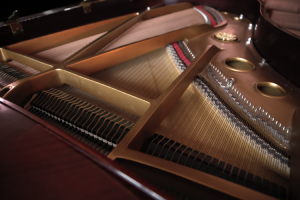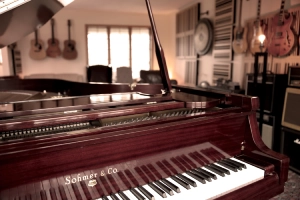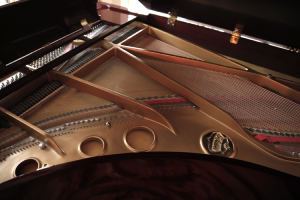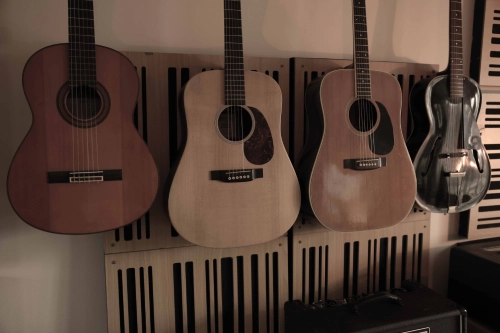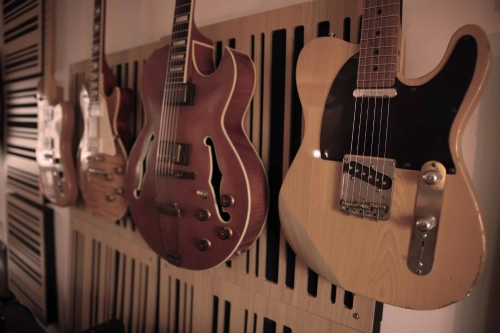Piano
For the majority of young students, piano is often viewed as the “least fun”
of the three instruments mentioned above. It certainly was for me growing
up. At the same time, it is the most rewarding in the long term. Moreover, if
an instrument is thought of as an interface to the universe of musical
syntax, the piano is arguably by far the most comprehensively robust
interface among traditional musical instruments. It still only nicks off a tiny
sliver of the infinite array of musical information - but it’s the most
functionally and extensive among the alternative slivers. That said, many
young students are far more motivated by “exciting” than “comprehensively
robust”.
Should a young student undertake piano training before drums and guitar?
I will say this - it matters to the extent that learning takes place. That is, 1-3
years of piano lessons with an average home workout routine of 0 - 30 min.
per week isn’t a terrific investment. At 1-3 hours per week at home, it
makes sense. Ideally, starting piano
and
an elective instrument at the
same time is the very best. One hour of in-studio training, split between
piano and an elective instrument, is exceptionally effective. The results are
multiplicative, in that the student internalizes the structuring of musical
information within the each instrument’s internal architecture, as well as the
structuring of musical information in the abstract, in a far more revealing
way than is available when using just a single interface, i.e. musical
instrument.
If a young student lacks a specific inclination as to what instrument to start
with, I would say the piano is far and above the most effective selection,
assuming a weekly at-home workout regimen. The physical and intellectual
demands of learning the piano - even at the beginning level - are far higher
than for any field of traditional academic study. It requires work.
Guitar
I am often asked if it is better for kids to start with acoustic guitar, if they
express interest in the electric guitar. If a young student is interested in the
electric guitar, I advise for that student to just start with the electric guitar.
The instruments are identical in terms of essential architecture - the tuning
is the same, the frets are the same, as are scale patterns, chord structures,
etc. The only appreciable difference is timbre, which affects what kind of
music is most likely to be played on it. But if a guitarist can play a Bach
Prelude, a Wes Montgomery tune, and a Led Zeppelin riff on one type of
guitar, they can play it on another type of guitar. One advantage of the
electric guitar for beginning-level students is that electric guitars tend to
have lighter strings than acoustic guitars, making them easier to play.
If a student is interested in acoustic guitar, then by all means, this is an
excellent choice. The choice then becomes whether to select a nylon string
instrument, i.e. a classical/flamenco/Spanish guitar, or a steel string guitar,
which is usually associated with folk, blues, and popular music. Unless a
parent is committed to their child learning classical or flamenco guitar, and
is prepared to supervise a highly structured at-home practice regimen,
purchasing a nylon string guitar is likely the first step in eventually giving it
away to someone else in the future. Classical and flamenco guitar are
highly satisfying to learn and study, however one is more likely to pursue
this after establishing an affinity for musical study in the aggregate. I would
equate it to inspiring kids to read by giving them a Walt Whitman
compendium.
For both acoustic and electric guitar, I incorporate digital recording to some
degree as the student develops. This serves two purposes. The primary
benefit is that a recording is akin to a performance, and an hour of
performing is worth ten hours of practice. Secondly, audio and video
production is becoming as ubiquitous today as word processing became by
the 1990’s. It is a skill that applies in multiple areas; especially in music.
Drums - Percussion
If a student is interested in learning two instruments, I would recommend
drums as the second instrument almost as much as the piano. All musical
training involves manipulating divisions of time, and percussion training
isolates this aspect of musical syntax. Also, as an adjunct to learning
another instrument, it requires less time investment to achieve benefit than does the piano.
Percussion training is an excellent adjunct for young
students learning either piano or guitar as a primary instrument.
Concurrent study of piano and drums/percussion is an exceptionally
beneficial training format, especially given that the pitched orchestral
percussion instruments such as marimba, et al are structurally identical to
the piano.The physical technique for playing each is unique, however the
logic is the same. Even more importantly, understanding the grammar and
syntax of both piano and drum/percussion music gives the student an
overwhelmingly comprehensive survey of musical vocabulary overall.
Within most musical genres, mastering syncopation is a significant aspect
of guitar training, making percussion an excellent complement to guitar
study for beginners and more experienced students alike.
As the sole instrument for the beginning student, drums are excellent
choice as well. For one, it is inherently compelling; especially for kids.
Students that start with the drums tend to stick with it longer - and work at it
more - than with most other instruments. It is the closest thing to the kind of
enjoyment that comes from improving at a sport. It’s fun to shoot baskets
and swing at the batting cages, and it’s fun to build sticking speed. There is
an excellent intellectual benefit to drum/percussion training as well. It is
inherently mathematical. Try counting in intervals of one, three, and four
simultaneously. In the context of jazz and many genres, it is the
drummer/percussionist that often possesses the highest level of musical
acuity and functional understanding in an ensemble.
While I incorporate notation reading gradually with all instruments - and
according to the individual student’s skills and interests - I advocate
learning to read notation the earliest for drum/percussion students. One
reason for this is that it is a limited “universe” - i.e. the learning curve for
reading drum notation is more approachable than it is for piano and,
especially, the guitar. Even more importantly, the relationship between
rhythm and written notation is more intuitively immediate with the drums
than it is with many pitched instruments - especially polyphonic instruments
like the guitar and piano - making the learning of notation a highly effective
means of understanding the instrument in the early stages of study.
Vocals
Aside from developing the ability to sing, vocal study also brings many of
the benefits usually associated with musical instrument study, and has its
own inherent advantages. It is perhaps the best way to learn how to read
notation, for a number of reasons. One is that the range is limited. For the
most part, vocal music is limited to a range of about 1.5 octaves, and is
always monophonic. But more importantly, learning to read music as a
vocalist requires that the student not only recognize that, for example, the
second lowest line in the treble clef represents the G above middle C, the
student also needs to know what that G will sound like in relation to the
note that comes before it in order to sing the note, whereas an instrumental
music student (at least a string instrument/percussion student) needs only
to identify the G and know where to place which finger/hand/foot. The
former actually involves reading, whereas the latter involves “decoding”, but
not actually reading, per se. Whether at the amateur or advanced level, a
vocalist with the ability to read notation will always have an advantage over
a vocalist lacking it.
Another advantage of vocal study is that, in comparison to instrumental
music, it takes much less time to master well enough to perform in public.
After a year of taking vocal lessons, a young student with a knack for
singing might even find an opportunity to perform in a professional theater
production, whereas an equally experienced and talented piano student, for
example, is likely to be years away from that kind of opportunity.
Whether as an instrumental or vocal music student, applied music study
offers a highly effective and valuable means of developing a student’s
intellectual and creative abilities.
